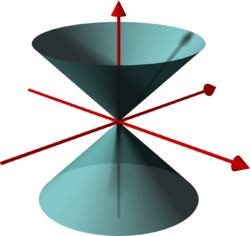A cone is a type of joint that is more conical than a typical joint or cigarette. The cone starts straight and thin but widens as the cone gets longer. A crutch or filter is often included and stops the cannabis from falling out of the bottom of the cone and it also stops resin from clogging the end of the joint.
In geometry, a cone is a three-dimensional figure that tapers smoothly from a flat base (typically a circle) to a point not contained in the base, called the apex or vertex.
| Cone | |
|---|---|
 A right circular cone with the radius of its base r, its height h, its slant height c and its angle θ. | |
| Type | Solid figure |
| Faces | 1 circular face and 1 conic surface |
| Euler char. | 2 |
| Symmetry group | O(2) |
| Surface area | πr2 + πrℓ |
| Volume | (πr2h)/3 |


A cone is formed by a set of line segments, half-lines, or lines connecting a common point, the apex, to all of the points on a base. In the case of line segments, the cone does not extend beyond the base, while in the case of half-lines, it extends infinitely far. In the case of lines, the cone extends infinitely far in both directions from the apex, in which case it is sometimes called a double cone. Each of the two halves of a double cone split at the apex is called a nappe.
Depending on the author, the base may be restricted to a circle, any one-dimensional quadratic form in the plane, any closed one-dimensional figure, or any of the above plus all the enclosed points. If the enclosed points are included in the base, the cone is a solid object; otherwise it is an open surface, a two-dimensional object in three-dimensional space. In the case of a solid object, the boundary formed by these lines or partial lines is called the lateral surface; if the lateral surface is unbounded, it is a conical surface.
The axis of a cone is the straight line passing through the apex about which the cone has a circular symmetry. In common usage in elementary geometry, cones are assumed to be right circular, i.e., with a circle base perpendicular to the axis. If the cone is right circular the intersection of a plane with the lateral surface is a conic section. In general, however, the base may be any shape and the apex may lie anywhere (though it is usually assumed that the base is bounded and therefore has finite area, and that the apex lies outside the plane of the base). Contrasted with right cones are oblique cones, in which the axis passes through the centre of the base non-perpendicularly.
Depending on context, cone may refer more narrowly to either a convex cone or projective cone. Cones can be generalized to higher dimensions.
English
Etymology
From Middle English cone (“corner, angle”) and conoun (“cone”), from Medieval Latin cōnus, cōnon (“cone, wedge, peak”), from Ancient Greek κῶνος (kônos, “cone, spinning top, pine cone”). Reinforced by Middle French cone, from the same Graeco-Latin source.
Pronunciation
- (Received Pronunciation) IPA(key): /ˈkəʊn/
- (General American) IPA(key





